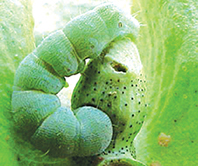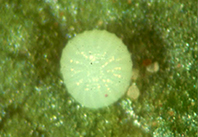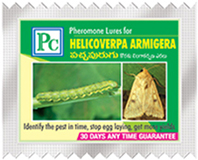
Pheromone Chemicals
Manufacturers of Pheromone Traps & Lures





Helicoverpa armigera
(Cotton bollworm) -is a highly polyphagous species and one of the most serious pests of field and vegetable crops. This pest has been recorded feeding on 182 plant species across 47 families in the Indian subcontinent, of which 56 are heavily damaged and 126 are rarely affected.
Life cycle
The female cotton bollworm can lay several hundred eggs, Under favourable
conditions, the eggs can hatch into larvae within 3 days and the whole lifecycle can be completed in just over a month.
The eggs are spherical and 0.4 to 0.6 mm in diameter, and have a ribbed surface. They are white, later becoming greenish.
The larvae take 13 to 22 days to develop, reaching up to 40 mm long in the sixth instar. Their colouring is variable,
but mostly greenish and yellow to red-brown. The head is yellow with several spots. Three dark stripes extend along the
dorsal side and one yellow light stripe is situated under the spiracles on the lateral side.
The pupae develop inside a silken cocoon over 10-15 days in soil at a depth of 4–10 centimetres, or in cotton bolls or maize ears.
The adult moth is stout, yellowish brown with a dark speck area on the forewings. Which have grayish wavy lines
and a black kidney shaped mark whereas the hind wings are whitish with blackish patch along the outer margin.
Host plants
The most important crop hosts are tomato, cotton, pigeon pea, chickpea, rice, sorghum, and cowpea. Other hosts include groundnut, okra, peas, field beans, soybeans, other Leguminosae, tobacco, potatoes, maize, flax, and a number of fruit trees and a range of vegetable crops.
Damage
1. Bolls showing regular, circular bore holes. 2. Larvae seen feeding on the boll by thrusting their heads alone inside and leaving the rest of the body outside. 3. Presence of granular faecal pellets outside the bore hole. 4. A single larva can damage 30-40 bolls.
ETL for Helicoverpa armigera is 8-10 No’s of moths per trap per day.
Use 8 No’s Pheromone Traps per acre from 1 week crop stage to obtain best results.
Trap canopy should be placed one feet above crop canopy to achieve optimum catch.
Recommended trap model : Phero-Sensor™- SP or Phero-Sensor™ - BP traps.
Recommended for: Cotton, Chillies, Tomato, Beans, Cabbage, pigeon pea, chickpea, cowpea, Cauliflower and Red gram, groundnut, okra, peas, field beans, soybeans, other Leguminosae, tobacco, maize, flax, and a range of vegetable crops.
© 2020 Pheromone Chemicals. All Rights Reserved | Powered by: Raviteja Designs